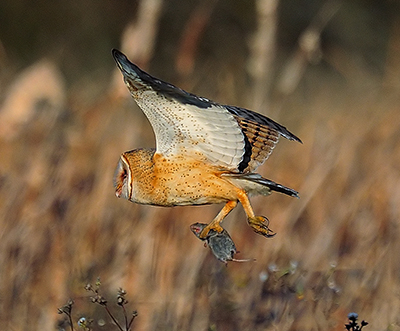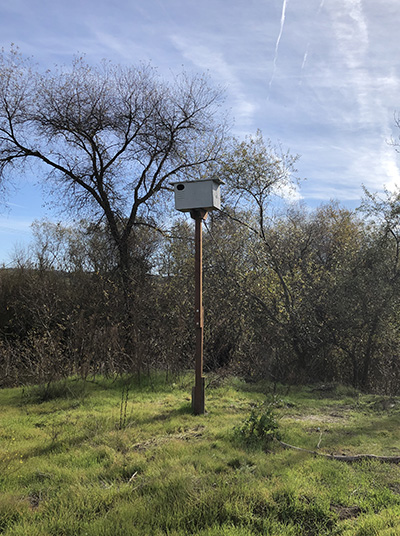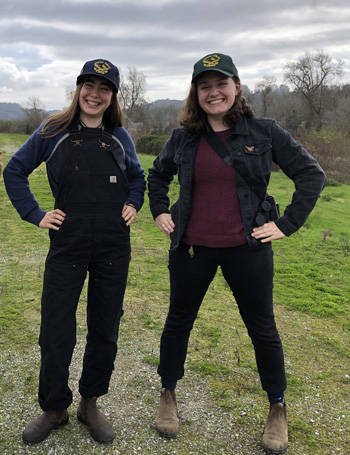Campus News
Recruiting raptors for rodent control along the Pajaro River levee
UCSC’s Predatory Bird Research Group is working with the Santa Cruz County Flood Control District to encourage hawks and owls to patrol the levee for rodent control.

DCIM100MEDIADJI_0027.JPG




A pilot project now under way along the Pajaro River levee in Watsonville is investigating the effectiveness of recruiting hawks and owls to help control populations of burrowing rodents, which can damage the levees and increase the risk of catastrophic flooding.
The project is a collaboration between the Predatory Bird Research Group at UC Santa Cruz and the Santa Cruz County Flood Control District, with help from Native Animal Rescue, Watsonville Wetlands Watch, and other organizations. Nest boxes for barn owls and hunting perches for hawks have been deployed along a 2.5-mile stretch of the river, and researchers are now monitoring both the burrowing activity of rodents and the hunting activity of raptors in the area.
Gophers and ground squirrels create extensive networks of underground tunnels, and when they burrow into the levee it can weaken the structure, leading to soil sloughing, erosion, and potentially even complete failure. Traditional pest management practices along the levee have included the use of fumigants to kill rodents in their burrows. But fumigation is expensive, and it also kills other animals that may be living in the burrows. Santa Cruz County has not been using anticoagulant poisons to kill rodents, due to their adverse effects on other species of wildlife.
“The Pajaro River is a great habitat corridor for wildlife, so it seemed like a good idea to find an alternative approach to rodent control, and the Pajaro Valley has a healthy and diverse raptor community that we could try to attract to the levee,” said Zeka Glucs, director of the Predatory Bird Research Group at UC Santa Cruz.
A friend at the flood control district reached out to Glucs after reading about a study in Ventura County on the use of raptor perches on the levees there. Many species of hawks, owls, and other raptors prey on rodents, including gophers and ground squirrels. Initial surveys indicated that pocket gophers were more active along the Pajaro River levee than ground squirrels, so Glucs said she hopes to attract barn owls, which are gopher specialists.
“We have a 50:50 ratio of barn owl nest boxes and raptor perches, whereas Ventura used more perches because they have more ground squirrels,” she said.
Glucs partnered with Native Animal Rescue of Santa Cruz County to help install the nest boxes and perches. Watsonville Wetlands Watch, meanwhile, has been helping with community outreach and education, including getting students at the local schools involved. Another partner in the project is Raptors Are the Solution, which is helping with outreach materials and educating the public about the impacts of rodenticides on raptors.
Although the county does not use anticoagulant rodenticides, they are often used by homeowners and others to control rats and other rodents. Because it may take more than a week for a rodent to die after eating poison bait, predators that could otherwise help control rodent populations are often sickened or killed after eating poisoned rodents. Predators that are commonly affected by rat poisons include bobcats, foxes, coyotes, hawks, and owls.
“We are concerned about the use of rodenticides in neighboring agricultural areas, so we are reaching out, providing information, and trying to get the community to buy into this project,” Glucs said.
Although the county has reserved the right to fumigate any particularly problematic burrows in the levee, they will otherwise not be fumigating in the study area. The county has begun using carbon monoxide for fumigation, which has no persistent effects in the environment and won’t harm the raptors the project aims to recruit to the levee.
The surveys to monitor the results of the project are mostly being carried out by UC Santa Cruz student interns, under Glucs’ supervision. UCSC’s Norris Center for Natural History is funding undergraduate internships and providing laboratory space for raptor pellet analysis (raptors cough up pellets of fur and bones that researchers can analyze to determine what the birds have been eating). The students are collecting data on rodent burrows and raptor activity in the 2.5-mile stretch where the nest boxes and perches were installed, as well as in another section of the river without those interventions for comparison.
“Hopefully we’ll get some resident barn owls. There’s some indication that one box is being used, and we’ll follow it to get a sense of how many young they raise,” Glucs said.
“The great thing about this project is that we have undergraduate research, community outreach, and raptor conservation all wrapped together, and that’s really our mission as a group,” she added. “This project is just getting started, and if it’s successful we hope to make it a larger, ongoing study with the capacity to train more undergraduates in field research.”